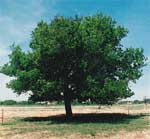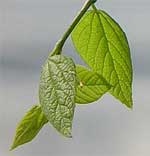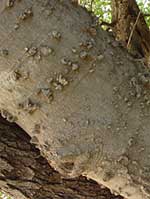
Netleaf Hackberry Tree
Scientific name: Celtis reticulata Torr.
Alternate Names: Western Hackberry, Sugarberry, Paloblanco
Description: A small native tree or large shrub growing to 30 feet with spreading crown and trunk diameter of 1 foot or more. Usually found along streams, canyons, and washes, in moist soil, plains grassland, upper desert, desert grassland, and woodland zones. Excellent for riparian restoration.
Leaves: The slightly heart-shaped, rough, dark green leaves have a noticeably lopsided shape. Where the leaf connects to the stem, one side of the leaf is often larger than the other.

Netleaf Hackberry Leaves
Leaves are alternate, the margins smooth, occasionally toothed near the base, 1 to 2 1/2 inches long and strongly veined. Leaves turn yellow in autumn.
Flowers: Inconspicuous, small, greenish flowers appear in March and April.
Fruits: Orange red, sweet, edible `cherries’ (drupes) about 1/4 to 3/8 inch in diameter, contain one seed. Birds seek out these drupes to eat.
Height: 25 to 30 feet & nearly as wide
Elevation: Less than 7500 feet

Netleaf Hackberry Fruit
Zones: 3 to 10
Water Requirements: 18 inches precipitation equivalent.
Habitat: This hackberry is mostly confined to areas with a constant water supply, such as moist soils along streams. Or needs supplemental water in other areas.

Netleaf Hackberry Bark
Sun Requirements: Full sun is the ideal condition for this tree, meaning it should get at least six hours of direct, unfiltered sunlight each day.
Uses: Windbreaks, landscapes, wildlife habitat & food, used as fuel and fence posts.
Advantages: When established, hackberry will perform admirably in urban conditions, desert heat, drought, strong winds, and dry, alkaline soils. They also have the virtue of deep roots that won’t crack nearby pavement and won’t prevent you from growing lawn beneath them.
Management & Care: Resistant to oak root fungus. Only pest problems of note seem to be occasional aphid attack and swollen leaf galls caused by insects. Witches broom (an occasional profusion of twigs near the ends of branches) does not debilitate or harm the tree.

